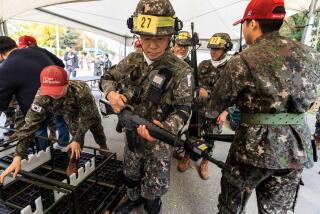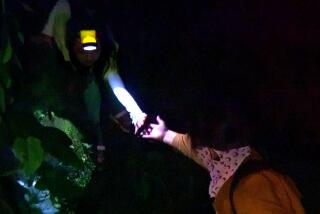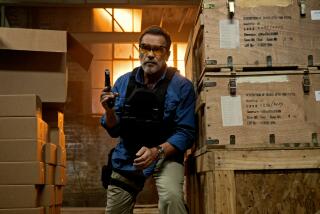A secret mutiny that went awry
SEOUL, South Korea — They were bootblacks, hobos, acrobats -- 31 ex-cons and ruffians plucked out of prison or off the streets and offered one last chance for redemption: to sneak into North Korea and kill its president, Kim Il Sung.
But nothing went according to plan. Their mission aborted, they ended up killing their trainers, fighting their way into the South Korean capital and blowing themselves up.
It was a severe embarrassment to South Korea’s dictatorship, and until military rule ended in the 1990s, few talked about it. And besides, who would believe a story so similar to the hit movie, “The Dirty Dozen,” about American military misfits on a World War II assassination mission?
Now, a movie based on the July 23, 1971, uprising is spurring renewed soul-searching over this touchy chapter.
“I cried all the way through the movie,” said Kim Bang-il, a former air force sergeant who trained the men and previewed the film. “The men and my colleagues killed by those they trained, they were all scapegoats of the Cold War and the government.”
“Silmido,” which opened Wednesday, remains true in its main elements to real-life events, critics say, and comes amid fresh scrutiny of the excesses carried out by South Korea’s former military regimes in the name of fighting communism.
It is one of South Korea’s costliest films, part of a new genre taking on once-taboo subjects such as domestic political intrigue or wartime cruelties. The movies appeal to a public that increasingly views North Korea as a misguided cousin rather than an archenemy.
But decades ago, the mood was different. The “Silmido” unit was forged in April 1968 to exact eye-for-eye revenge from North Korea.
Three months earlier, on Jan. 21, 1968, 31 North Korean commandos had achieved the unimaginable -- trudging undetected for about 40 miles from the border to the forested hill behind the palace of South Korean President Park Chung-hee in downtown Seoul.
Only at the last minute did South Korean security forces repel the assault.
Hee decided to strike back.
The 31 hard-case misfits were assembled on Silmido, an islet 40 miles west of Seoul, and offered a chance to erase their pasts and start anew -- if they survived.
“Their goal was to blast Kim Il Sung’s palace in Pyongyang and cut his throat,” said former drill sergeant Kim, now 58, who escaped death at the hands of his men because he was away on leave.
In October 1968, after brutal training during which three of the men died, the squad set out for North Korea in rubber boats, but was ordered back. Park’s regime had decided not to disrupt the budding U.S.-Soviet detente.
The island commanders recommended the men be reassigned or disbanded. But higher-ups in Seoul offered no word on their fate. So they were returned to the island, and the hellish training resumed. It continued for nearly three years, until they rebelled on Aug. 23, 1971, murdered 18 of their 24 trainers, commandeered a boat and set out for the capital.
Once in Seoul, they encountered a roadblock of soldiers. After a gun battle, the outnumbered rebels finally blew themselves up with grenades. Four survivors were later executed.
Only recently has South Korea admitted sending thousands of spies on missions to North Korea between the end of the 1950-53 Korean War and 1972, the year when both Koreas agreed to reduce tensions. Three hundred were killed, 203 wounded, 130 arrested and 4,849 went missing -- without word or recompense from a government that wanted it all kept hush-hush.
With the veil of silence lifted, partly because of new films like “Silmido,” hundreds of ex-commandos have staged violent protests in recent months demanding compensation for their hardships and losses.
The National Assembly is now deliberating on a bill for repayment.
More to Read
Only good movies
Get the Indie Focus newsletter, Mark Olsen's weekly guide to the world of cinema.
You may occasionally receive promotional content from the Los Angeles Times.










